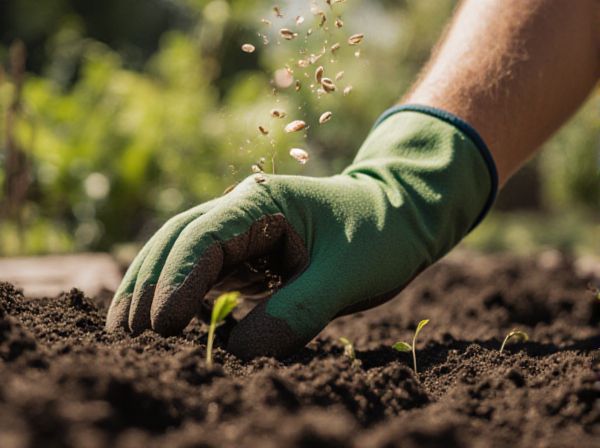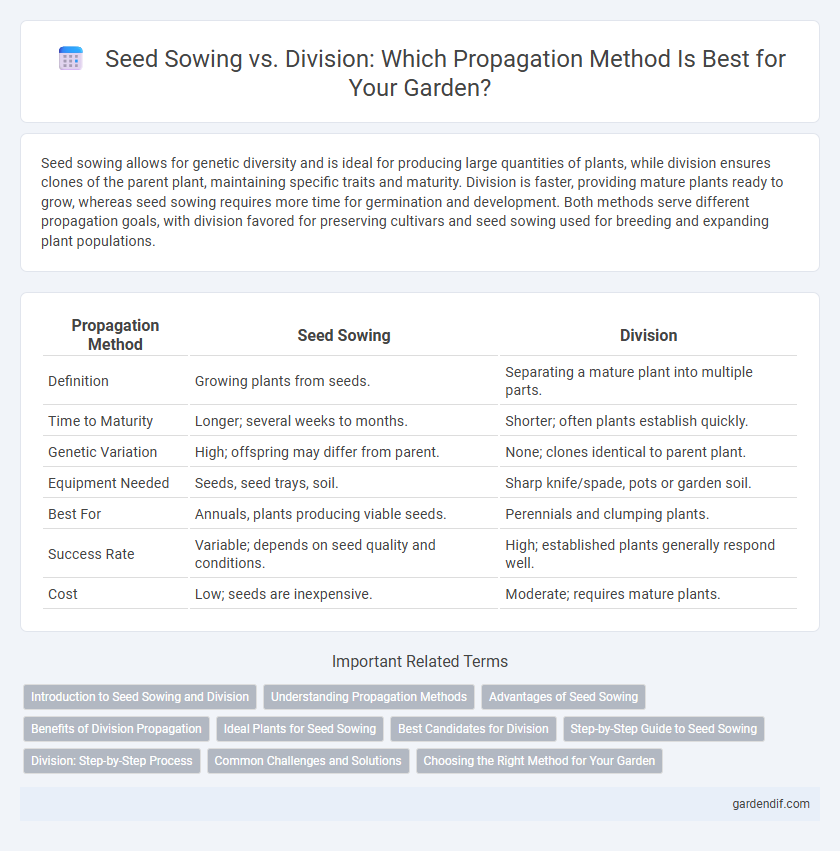
Seed Sowing vs Division Illustration
Seed sowing allows for genetic diversity and is ideal for producing large quantities of plants, while division ensures clones of the parent plant, maintaining specific traits and maturity. Division is faster, providing mature plants ready to grow, whereas seed sowing requires more time for germination and development. Both methods serve different propagation goals, with division favored for preserving cultivars and seed sowing used for breeding and expanding plant populations.
Table of Comparison
| Propagation Method | Seed Sowing | Division |
|---|---|---|
| Definition | Growing plants from seeds. | Separating a mature plant into multiple parts. |
| Time to Maturity | Longer; several weeks to months. | Shorter; often plants establish quickly. |
| Genetic Variation | High; offspring may differ from parent. | None; clones identical to parent plant. |
| Equipment Needed | Seeds, seed trays, soil. | Sharp knife/spade, pots or garden soil. |
| Best For | Annuals, plants producing viable seeds. | Perennials and clumping plants. |
| Success Rate | Variable; depends on seed quality and conditions. | High; established plants generally respond well. |
| Cost | Low; seeds are inexpensive. | Moderate; requires mature plants. |
Introduction to Seed Sowing and Division
Seed sowing and division represent two fundamental propagation methods in horticulture crucial for plant reproduction and cultivation. Seed sowing involves planting seeds directly into the soil, promoting genetic diversity and long-term plant vigor, while division entails physically separating established plants into multiple parts for immediate growth of identical clones. Understanding these techniques enables gardeners to select the most suitable propagation strategy based on plant species, growth patterns, and cultivation goals.
Understanding Propagation Methods
Seed sowing and division represent two fundamental propagation methods with distinct advantages. Seed sowing promotes genetic diversity and is ideal for producing large quantities of plants from annuals or those that breed true to seed. Division enables cloning of mature plants, ensuring uniformity and faster establishment in perennials or plants with clumping growth habits.
Advantages of Seed Sowing
Seed sowing offers several advantages such as producing a large number of plants at a lower cost and enabling greater genetic diversity, which enhances disease resistance and adaptability. This method allows for easier storage and transportation of seeds compared to bulky plant divisions. Furthermore, seed propagation supports long-term plant breeding and hybridization, making it ideal for developing new plant varieties.
Benefits of Division Propagation
Division propagation offers faster plant establishment compared to seed sowing, allowing mature plants to develop more quickly. It ensures true-to-type offspring by producing clones, maintaining the genetic characteristics of the parent plant without variation. Division also reduces the risk of seed-borne diseases, promoting healthier plant growth and higher survival rates.
Ideal Plants for Seed Sowing
Ideal plants for seed sowing include annuals like marigolds, zinnias, and sunflowers, which produce abundant seeds and germinate quickly. Vegetables such as tomatoes, peppers, and beans are also well-suited for direct seed sowing due to their high seed viability and ease of transplanting. These species benefit from genetic diversity and are cost-effective for large-scale propagation compared to division methods.
Best Candidates for Division
Best candidates for division propagation include perennials such as hostas, daylilies, and irises that develop multiple crowns or clumps. Plants with fibrous root systems and those that naturally form offsets, like chrysanthemums and certain ornamental grasses, respond well to division. Division ensures rapid establishment and rejuvenation of mature plants, making it ideal for species that do not propagate easily from seed.
Step-by-Step Guide to Seed Sowing
Begin seed sowing by selecting high-quality seeds and preparing a sterile seed tray filled with moist, well-draining seed-starting mix. Sow seeds evenly on the surface, pressing them lightly into the soil without burying too deep, then cover with a fine layer of the mix or vermiculite. Maintain consistent moisture and warmth by covering with a plastic dome or plastic wrap until germination occurs, typically within 7-21 days depending on the species.
Division: Step-by-Step Process
Division propagation involves separating a mature plant into multiple sections to create new plants, ensuring genetic consistency. Begin by carefully digging up the plant and gently shaking off excess soil to expose the root system; use a clean, sharp tool to divide the roots and crowns into individual sections, each containing stems and roots. Plant each division promptly in prepared soil, water thoroughly, and provide appropriate care to encourage healthy growth and establishment.
Common Challenges and Solutions
Seed sowing often faces challenges like slow germination, uneven seedling growth, and susceptibility to damping-off disease, which can be mitigated by using treated seeds, maintaining optimal soil moisture, and ensuring proper ventilation. Division encounters issues such as transplant shock, root damage, and uneven division of rhizomes; careful handling of root systems, sterilizing cutting tools, and dividing during dormant periods help improve success rates. Both propagation methods benefit from tailored soil preparation and consistent monitoring to address their unique growth requirements and minimize plant stress.
Choosing the Right Method for Your Garden
Seed sowing offers genetic diversity, ideal for creating unique plant varieties, while division ensures rapid establishment of mature, true-to-type plants. Choose seed sowing for annuals, wildflowers, or hybrid experimentation, and division for perennials, bulbs, and overcrowded clumps needing rejuvenation. Matching propagation methods to plant type and garden goals maximizes growth success and landscape beauty.
Seed Sowing vs Division Infographic

 gardendif.com
gardendif.com